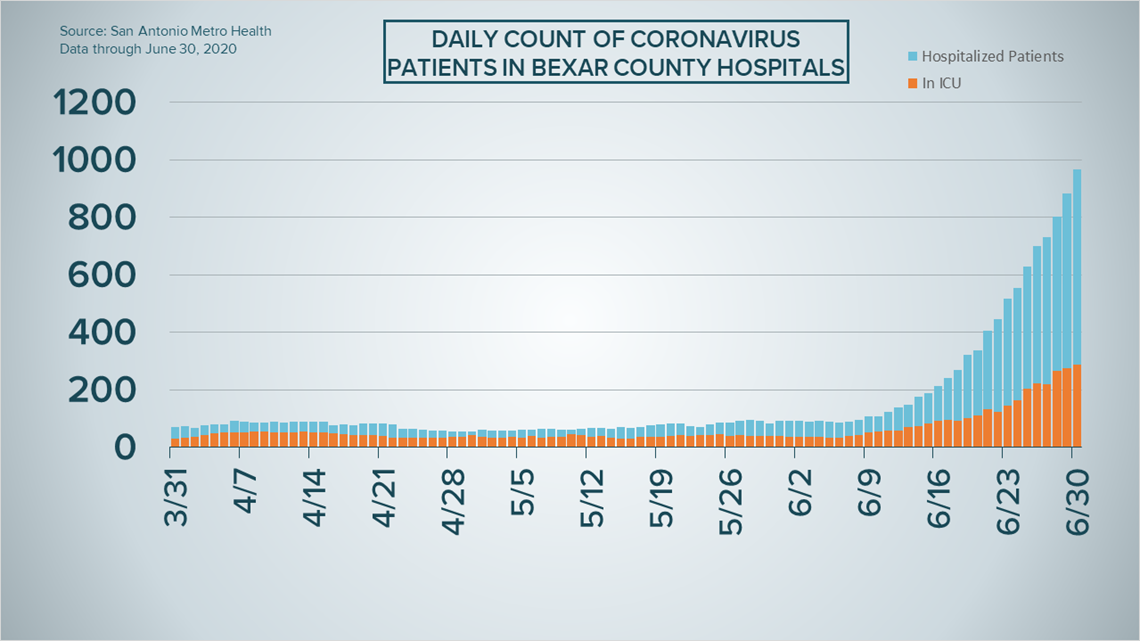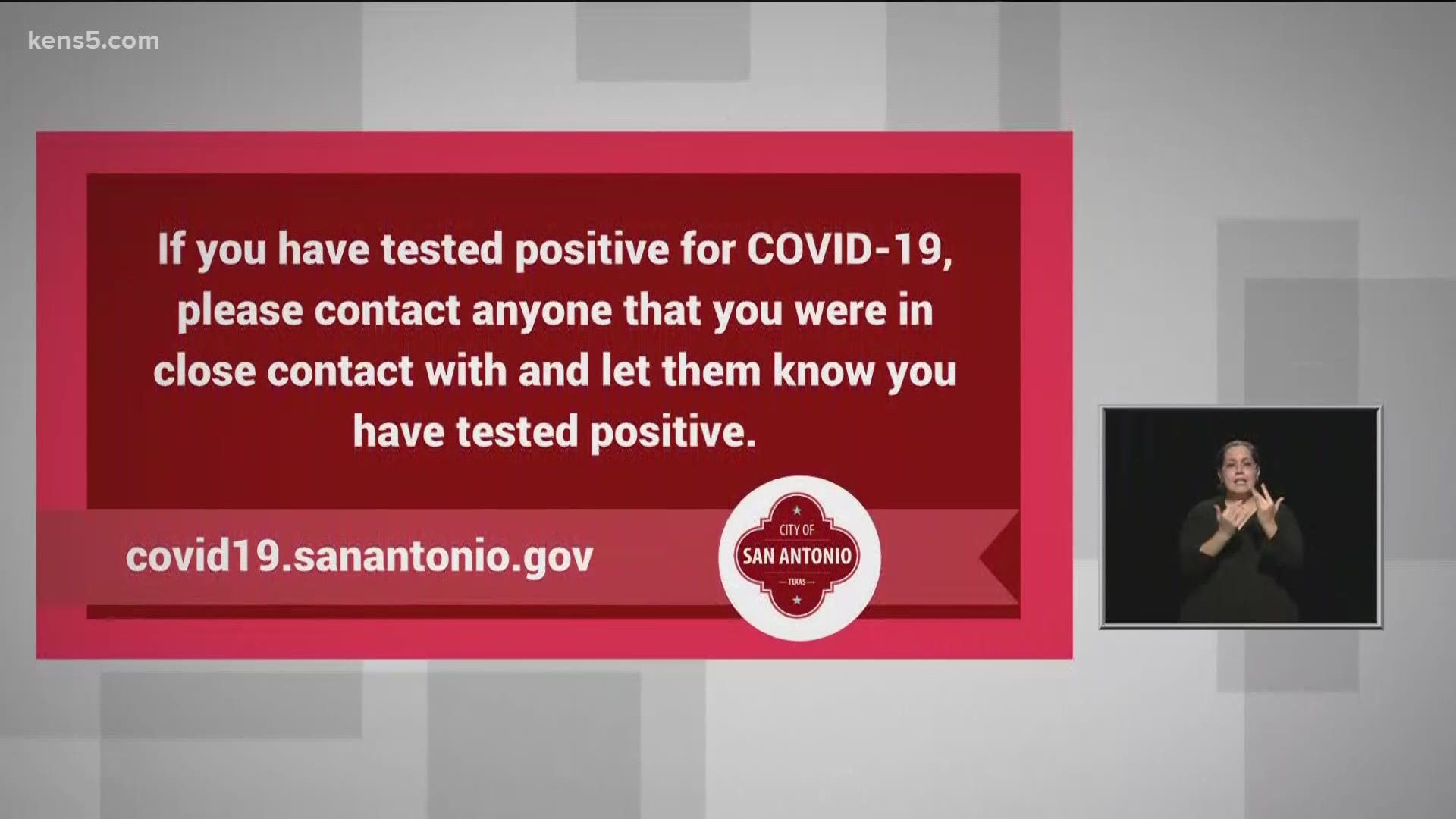SAN ANTONIO — We're tracking the latest numbers from the coronavirus pandemic in San Antonio and across Texas. Here are the latest numbers reported by Bexar and surrounding counties:
- Bexar County: 1,268 new cases were reported Tuesday, along with one additional death. There is a total of 12,065 cases and 110 fatalities in the county. 966 patients are in local hospitals, and 288 are in the ICU.
- Comal County: The county reported 124 new coronavirus cases and one fatality Wednesday. Eight people have now died in the county, while 275 have recovered. The positivity rate has risen to 12.17%, the highest the county has recorded since the pandemic began. As of Wednesday, there is a total of 778 confirmed and probably coronavirus cases in Comal County.
- Hays County: 158 new cases and one new death reported Tuesday, bringing the total to 2,819 cases and seven fatalities in the county. 83% of those cases are considered active, and 50% of the county's confirmed cases are people between the ages of 20 and 29.
Here are Tuesday's full numbers. Bexar County reports them daily at 7 p.m.:
How Bexar County is trending:
We're tracking how many coronavirus cases are confirmed in Bexar County each day from the time San Antonio Metro Health began reporting cases more than two months ago. Graphing those daily case numbers along a 14-day moving average provides an accurate picture of the curve in the San Antonio area and the direction we're heading amid the coronavirus.
Metro Health reported 1,268 newly confirmed cases of the coronavirus in Bexar County Tuesday, bringing the total to 12,065. That is by far the highest daily increase since the start of the pandemic. One new virus-related death was reported, so the total remains at 110 fatalities.


Meanwhile, 966 COVID-19-positive patients are in local hospitals—another high-water mark for Bexar County. This is a jump of 85 from Monday. Mayor Nirenberg noted that the number of coronavirus patients in San Antonio area hospitals is rising at around 10% day over day.
There are currently 288 people under intensive care in area hospitals and 158 patients are currently on ventilators, up from 41 just two weeks ago. Both of those numbers are record highs.


At the briefing Tuesday, Bexar County Judge Nelson Wolff announced that a new order going into effect July 2 will require indoor businesses to check temperatures and ask employees and customers about symptoms. He said social gatherings will also be limited to 10 people or fewer ahead of the Fourth of July weekend.
Coronavirus in Texas
Texas reported 6,975 new COVID-19 cases Tuesday, a new record high. There had been at least 5,000 new cases reported in seven of the last eight days. Nearly 40,000 new cases have been confirmed in the state in the past week.


21 new virus-related fatalities were reported by the state on Tuesday, bringing the total to 2,424.
The number of current patients in Texas hospitals increased to a new record high of 6,533. This number has steadily increased over the past three weeks, and the increase of 620 from Monday is a new record for the daily increase.


Latest Coronavirus Headlines
- 'Limit gatherings to only family members' | Tips on preventing spread of COVID-19 July 4 weekend
- Thousands of doctors ask Texas Republicans to cancel in-person convention at GRB in Houston
- Beyond COVID-19: San Antonio's resilient economy embraces the future | COMMERCE STREET
- Biden hammers Trump for handling of COVID-19 pandemic
- Mnuchin says hardest-hit businesses should be focus of next stimulus aid
- Your phone may have up to 10 times more bacteria than a toilet seat; how to clean it properly
- County beaches at South Padre Island to close Tuesday through July 13
- Fauci said US could reach 100,000 new coronavirus cases a day
- Florida coronavirus case numbers, hospitalizations, deaths
- 'It is very concerning' | CDC expert warns US far from containing coronavirus
Coronavirus symptoms
The symptoms of coronavirus can be similar to the flu or a bad cold. Symptoms include fever or chills, cough, shortness of breath or difficulty breathing, fatigue, muscle or body aches, headache, new loss of taste or smell sore throat, congestion or runny nose, nausea or vomiting and diarrhea, according to the Centers for Disease Control.
Most healthy people will have mild symptoms. A study of more than 72,000 patients by the Centers for Disease Control in China showed 80 percent of the cases there were mild.
But infections can cause pneumonia, severe acute respiratory syndrome, kidney failure, and even death, according to the World Health Organization. Older people with underlying health conditions are most at risk.
On June 25, the CDC expanded the list of groups at a higher risk of severe illness due to coronavirus.
Experts determined there was consistent evidence these conditions increase a person's risk, regardless of age:
- Chronic kidney disease
- COPD (chronic obstructive pulmonary disease)
- Obesity (BMI of 30 or higher)
- Immunocompromised state (weakened immune system) from solid organ transplant
- Serious heart conditions, such as heart failure, coronary artery disease, or cardiomyopathies
- Sickle cell disease
- Type 2 diabetes
The CDC believes symptoms may appear anywhere from two to 14 days after being exposed.
Human coronaviruses are usually spread...
- Between people who are in close contact with one another (within about 6 feet).
- Through respiratory droplets produced when an infected person coughs, sneezes or talks. These droplets can land in the mouths or noses of people who are nearby or possibly be inhaled into the lungs.
- Some recent studies have suggested that COVID-19 may be spread by people who are not showing symptoms.
Help stop the spread of coronavirus
- Stay home when you are sick.
- Eat and sleep separately from your family members
- Use different utensils and dishes
- Cover your cough or sneeze with your arm, not your hand.
- If you use a tissue, throw it in the trash.
Lower your risk
- Wash your hands often with soap and water for at least 20 seconds. If soap and water are not available, use an alcohol-based hand sanitizer.
- Avoid touching your eyes, nose, and mouth with unwashed hands.
- Avoid close contact with people who are sick.
- Clean and disinfect frequently touched objects and surfaces.
- The CDC recommends wearing a mask or cloth face covering if you have to be out due to an essential service or essential activity such as going to the grocery store.
- If you are 60 or over and have an underlying health condition such as cardiovascular disease, diabetes or respiratory illnesses like asthma or COPD, the World Health Organization advises you to try to avoid crowds or places where you might interact with people who are sick.

